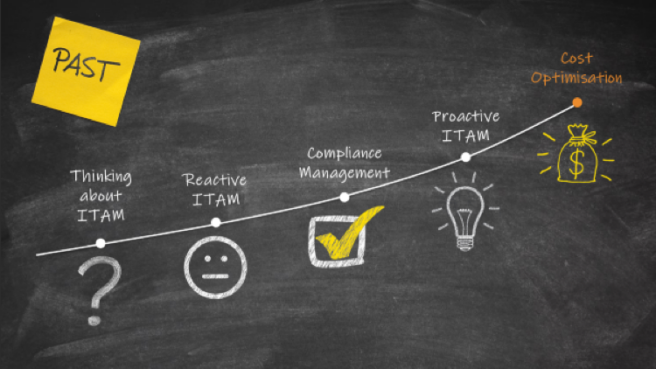The Evolution of ITAM Maturity Part I

As we’ve shared this research with colleagues, customers and partners, it has evolved based on insight into the challenges they are facing. The stories they’ve shared with us have been combined with our own experience and broader research to give a more complete picture of the past, present and future of ITAM. Through this process it became clear that ‘what good looks like’ has changed, and the ITAM maturity models that are currently in use need to change to reflect this.
Most ITAM maturity models are focused primarily on SAM and have been developed by software vendors or SAM vendors based on generic models. The descriptions used by the vendors are rarely SAM specific, although they may include a few token references, but in general could be applied to pretty much any discipline.
What good used to look like
We started by taking our research, customer stories and experiences, and building a model of what good ITAM used to look like. We initially wondered whether to use an existing model, but soon realized that the generic nature of these meant that they didn’t really describe reality. So, we drew our own (see Fig 1 below)
Figure 1: What the ITAM Maturity Curve Used to Look Like
Maturity level descriptions
As we drew this model, we also realized that traditional definitions aren’t always helpful. These descriptions aren’t intended to be formal definitions but describe the realities of the challenges and achievements encountered by ITAM practitioners at each stage. I expect these to strike a chord with many of you.
Thinking about ITAM
Someone is given a job title, or the responsibility is included in a broader job description. No real objectives, metrics or KPIs are in place around delivering any capability. People in this situation often start by researching what ITAM is. Most didn’t choose this as a career move.
reactive ITAM
At this stage, ITAM is primarily focused on dealing with audits on an ad-hoc basis. There’s no process or methodology, but a lot of chasing people for information, which is dispersed across the organization and gathered manually. Vendors are allowed to run scripts and generally given free access. Controls are poor. Hardware is reviewed annually to confirm what’s there.
Compliance management
Priorities are still audit driven, so very much software-focused. By now, there is an audit management process, and vendor scripts are reviewed before being run (or we have our own data sources). There may be some basic license management for those vendors rumored to be most likely to audit. Hardware has probably been forgotten in the attempt to get to grips with software. Annual reconciliation of key vendors – MS desktop may be done quarterly. Working primarily in Excel with basic inventory data and whatever procurement can give us about purchases.
Proactive ITAM
There is now some basic governance (policy & high-level processes) in place. By this stage we’re getting the hang of the data – or at least where the gaps are – but we’re still software focused as that’s where the pain is, with priorities audit/compliance driven. Some support & maintenance renewals are also being managed using SAM data as procurement begin to engage with SAM. At this point, IT organizations are also starting to integrate SAM into IT and project management workflows.
Cost optimisation
ITAM at the cost optimization stage is mostly for desktop software, with some (mainly Windows) datacenter visibility. While IT asset managers are aware of issues that need addressing around mobile, SaaS, IaaS and other cloud services, they lack capacity, resource, ability and sponsorship to make progress. There is more visibility within the organization, there is some budget for ITAM, audits are manageable, and support & maintenance renewals are under control. The ITAM function is providing information to finance to support budgeting, while procurement is using data to right size contracts. There is some license reharvesting for key products and vendors, and there may be a SAM tool implemented, but not fully leveraged. If there isn’t then the IT asset manager is building the business case for the technology to support increasing ITAM capability.
CONCLUSION
While traditional ITAM maturity may still have many challenges for the majority of IT asset managers, it’s important to remember many have achieved amazing things given a lack of resources – time, money, people and technology. Even when cost optimization has been achieved for some assets, there are always improvements to be made – but cost optimization is no longer enough to keep ITAM relevant in a world where IT is no longer just about managing risk and cost, but about supporting innovation and growth as organizations across all sectors and geographies face up to the challenges of digital transformation. In the next part of this blog series, we’ll look at how ITAM maturity has evolved, and what good looks like now.
To learn more about the evolution of ITAM Maturity, watch the recording of our recent webinar ‘Building the Business Case for SAM’. As part of our ITAM best practice webinar series, Victoria equips you with step-by-step advice on how to identify and engage critical stakeholders. Listen on-demand now.